Abstract
Attenuated total reflectance-Fourier transform infrared ppectroscopy (ATR-FTIR) proved to be a reliable, rapid, and easy-to-use technique to evaluate vegetable oils quality and authenticity. The spectral range of the middle infrared region (MIR) of FTIR spectra, from 4000 to 600 cm−1, has been commonly used to fingerprint specific functional groups of lipids and their modified forms induced by oxidation of thermal treatment. The applicability of FTIR-MIR spectroscopy in assessing oil fingerprinting and quality parameters is crucially dependent on the chemometric methods, including calibrations with authentic samples. We report here the evaluation of seven types of cold-pressed functional oils (sunflower, pumpkin, hempseed, soybean, walnut, linseed, sea buckthorn) produced in Romania, provided directly from small enterprises (as genuine, process-controlled authentic samples) comparative to commercialized samples. Concomitantly, olive oils of similar claimed quality were investigated. The ATR-FTIR-MIR data were complemented by UV–Vis spectral fingerprints and multivariate analysis using Unscrambler X.10.4 and Metaboanalyst 4.0 software (e.g., PCA, PLSDA, cluster analysis, heatmap, Random forest analysis) and ANOVA post-hoc analysis using Fischer’s least significant difference. The integration of spectral and chemometric analysis proved to offer valuable criteria for their botanical group recognition, individual authenticity, and quality, easy to be applied for large cohorts of commercialized oils.
1. Introduction
Vegetable oils are essential food components of high nutritional value and major agrofood commodities subjected to adulteration. Consumers and food producers are concerned about their quality and safety influenced by multiple environmental and technological factors (oxidation, higher levels of trans fatty acids) and adulteration before commercialization.
Authenticity is a very important quality criterion for edible oils, considering the significant differences of composition, safety, and price between the cold-pressed (extra virgin, virgin) and refined ones, as well as possible mislabeling of commercial products.
Over the past few decades, Fourier transform infrared (FTIR) spectroscopy had provided a reliable analytical tool in the fat and oil industries and become an attractive alternative to traditional methods, being a rapid and easy-to-use technique to evaluate qualitatively or even quantitatively the oils’ edibility, their intrinsic quality parameters, safety, as well as authenticity, traceability and adulteration [,,,,,,]. Moreover, the determination of edible oil authenticity, compared with the more accurate but time-consuming, laborious, and expensive chromatography-based method is advantageous as a more rapid and cheaper solution. Considering the advantages of being non-destructive, cost effective and environmentally friendly, using small amounts of liquid samples and simple preparation procedures [], FTIR spectroscopy was found to be superior for the discrimination and classification of edible oil comparing to FT-Raman and FT-NIR [].
The spectral range of the middle infrared region (MIR) of FTIR spectroscopy, from 4000 to 400 cm−1, has been commonly used for the identification of organic groups, based on their characteristic, fundamental vibrations as well as for the quantitative evaluation of components if adequate calibrations were complemented []. The FTIR-MIR spectroscopy with attenuated total reflectance (ATR) or transmission cell accessories has been used to authenticate, identify or classify fats and oils [,,,], the ATR accessory being a better choice due to its ability to handle easily liquid samples, requiring minimum preparation. It is also an excellent tool for quantitative analysis, because the intensities of the spectral bands are proportional to concentration. It is useful to distinguish oils from different botanical origins using specific wavenumber domains coupled with non-supervised classification techniques [,]. FTIR-ATR spectrometry has been used mainly for (extra) virgin olive oils to distinguish from different genetic varieties [] and geographical origins [,], meanwhile, the scientific interest for other functional oils showing health benefits is increasing.
The applicability of FTIR-MIR spectroscopy in assessing oils fingerprinting and quality parameters is crucially dependent on the chemometric methods, including calibrations with large and representative sample numbers. The chemometric strategies and methods for spectroscopy-based food authentication have been reviewed [,]. The common chemometric qualitative and classification non-supervised approaches include principal component analysis (PCA), cluster analysis (CA), or soft independent modeling of class analogy (SIMCA), while the supervised methods include partial least squares (PLS) with discriminant Analysis (PLSDA), linear discriminating analysis (LDA) and principal component regression (PCR) [,,]. The chemometric algorithm used in PCA and PLS has been extensively used to obtain different quality parameters of edible oils [,,] and applied to the evaluation of fatty acids composition and other quality parameters of virgin olive oil [,].
The Random forest algorithm has been applied as a one-class classifier in FTIR spectroscopy for food adulteration and showed superior performance comparing to PLS-DA and SIMCA, for classification and authentication in chemometrics []. The web-based software MetaboAnalyst 4.0 (https://www.metaboanalyst.ca/) is a complex processing tool which accepts a variety of input data (from NMR and MS to FTIR peak lists) and offers a number of chemometric options for data processing, from univariate (ANOVA t-test) to multivariate statistical analysis, PCA, PLS-DA, CA, heatmaps, Random forest and a number of more sophisticated statistical or machine learning methods [].
Different reviews [,] and experimental data have been reported, about the FTIR spectroscopy applied for the characterization of edible (especially olive) oil quality [,,,], as well as for the freshness evaluation [] and detection of adulteration [,,,,]. A large majority of data refer to olive oil adulteration with low cost edible oils [,,] or to assess oil oxidation [,,]. Fewer references are related to specialty, functional oils which have beneficial impacts on health and cardiovascular or other disease prevention. To mention, some articles reported the FTIR fingerprint of walnut, linseed and soybean oils, pumpkin [,,,], hempseed oils [] or sea buckthorn oils []. The grapeseed, nigella seed neem oils, as well as wheat germ, sesame oils or flaxseed, coconut and rosehip oils which exhibit pleasant flavor and health benefits are often counterfeited and adulterated with other low-cost oils, drawing wide attention [,,,,,,].
The evaluation of different liquid foods (beverages, fruit juices) as well as edible oils, using ATR-FTIR fingerprinting, represented our previous interests and former investigations using complementary techniques, such as UV–Vis spectrometry, ATR-FTIR-MIR spectrometry, liquid chromatography coupled with diode-array or mass spectrometry (MS) detection MS detection, or gas-chromatography coupled with MS [,,,,,,].
We report here the evaluation of seven types of cold-pressed functional oils produced in Romania, provided directly from small enterprise manufacturers (as genuine, process-controlled authentic samples) and comparatively from similar oil types (including also olive oils), as commercial samples labeled as “cold-pressed” or extra-virgin.
We applied UV–Vis spectrometry and ATR-FTIR-MIR spectroscopy, to identify the specific fingerprints of oils from different botanical origins and related to their quality, compared to commercial oils of the same botanical origin, possibly mislabeled or adulterated. The FTIR data were analyzed by chemometrics successively using Unscrambler X.10.4 and Metaboanalyst 4.0 software. Finally, we were able to consider the most relevant biomarkers, to classify and discriminate the eight oil types based on their botanical origin, authenticity, and quality.
2. Materials and Methods
2.1. Oil Samples
Eight groups, including 30 edible oils were used in this study. From each group, one sample was confirmed to be “authentic” and process-controlled, provided from trusted manufacturers. The other samples were commercial, labeled as “extra virgin” or “cold-pressed” and purchased from retailers. All oils (excepting olive oils) were produced in Romania and had different brand names (abbreviated in this study). Table 1 contains data about their botanical origin, the declared/labeled quality grade, the brand abbreviation and codes which were used in classification studies. The last column shows the authentic samples where the production and quality control were carefully supervised.

Table 1.
The botanical origin, the declared/labeled quality grade, the brand abbreviation and codes which were used in classification studies.
2.2. UV–Vis Spectrometry
A volume of approx. 10 mL from each oil was mixed with 10 mL hexane, vortexed for 3 min, centrifuged, and filtered through 0.25 microns membrane. Appropriate dilutions were made depending on the absorption peak intensities, measured with a Jasco V 530 double beam spectrometer. The UV–Vis spectra were recorded in the regions 200–360 nm and 400–700 nm, the maximum absorption wavelengths being recorded.
2.3. ATR-FTIR Analysis
The Fourier Transform Middle Infrared spectra (FT-MIR) with attenuated transmission (ATR) were recorded using a Prestige-21 FTIR spectrophotometer (Shimadzu, Japan) with a resolution of 4 cm−1 at 32 scans and an internal reflection accessory. A small quantity of the oil samples (approx. 8 microliters) was deposited directly on the diamond ATR crystal plate which was carefully cleaned with pure chloroform to eliminate the presence of oil residues between measurements and dried using nitrogen gas after each experiment to ensure a clean crystal surface and to obtain the best possible sample spectra. The collection time for each sample spectrum was approximately 2 min. Duplicated spectra were recorded for all oil samples, scanned in the absorbance mode from 3600 to 650 cm−1. After every scan, the spectra were subtracted against background air spectrum. The spectra were recorded in absorption mode at each data point. Considering previous references [,] the most relevant FTIR spectroscopic wavenumber regions to identify and authenticate vegetable oils were considered, as presented in Table 2.

Table 2.
FTIR wavenumber regions of vegetable oils, correlated with the mode of vibration for specific functional groups, considered as predictor variables for statistical data processing [,,].
From each FTIR spectrum, the raw matrix M0 representing the peak intensities as a function of wavenumber for the whole domain was used for untargeted statistical analysis. After a preliminary selection of the main peaks or sub-domains seen in the raw spectra, a new matrix M representing mean intensities as a function of wavenumber for each sample was built, for a semi-targeted chemometric analysis.
2.4. Chemometrics
The raw data matrix (M0) representing the absorption intensities at each wavenumber from the whole region (3600 to 700 cm−1) were statistically processed using the Unscrambler X10.4 software (Camo, Norway). The multivariate unsupervised analysis principal component analysis (PCA) was applied first as a preliminary evaluation of the sample classification. In a second step, a semi-targeted statistical analysis was applied on matrix M, using the web-based software for metabolomics, Metaboanalyst 4.0 (https://www.metaboanalyst.ca/). This multivariate analysis included the PCA, PLSDA, CA, correlation matrices including heatmap, Random forest analysis and ANOVA post-hoc analysis using Fischer’s least significant difference (LSD).
3. Results
3.1. UV–VIS Spectra Fingerprints Related to Botanical Origin
The UV–Vis absorption spectra as a first indicator of oils’ group fingerprint are presented in Figure 1.
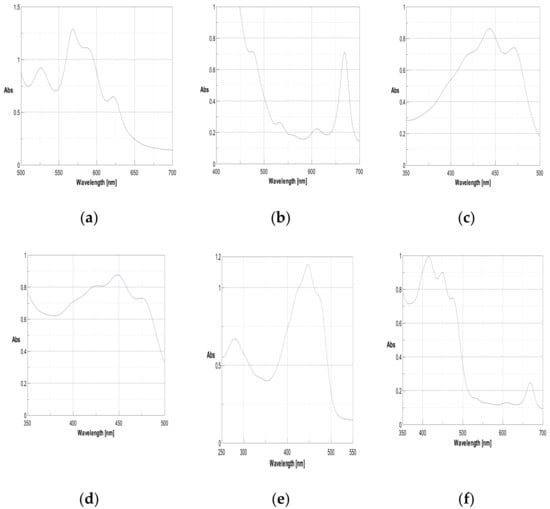
Figure 1.
Typical spectral fingerprints of six authentic oils absorbing in the Vis region (360–700 nm): (a)—Pumpkin oil; (b)—Hempseed oil; (c)—Linseed oil; (d)—Soybean oil; (e)—Sea buckthorn oil; (f)—Olive oil.
The individual UV–Vis absorption spectra showed specific criteria of recognition based on the spectra shape and absorption maxima. The SFO and WO oils (group I and VI) had specific absorptions in the UV region (220–280, 325 nm) and 220–280 nm, respectively, with no relevant absorptions in the Vis region. The PO group II was recognized by intense peaks at 526, 568, 590 and 620 nm, indicating their carotenoid, acylated anthocyanin and chlorophyll content, respectively. The spectra of LSO and SO oils (group III and V) were similar, with maxima at 448 and 443 nm, respectively. Hempseed (HO, group IV) and olive oils (EVOO, group VIII) were characterized by high absorption intensities at 668 nm (indicator of chlorophylls). The sea buckthorn (SBO) oils group VII had a unique fingerprint with maxima at 447/470 nm (due to high carotenoid content) and a lower intensity at 668 nm (chlorophylls). These spectra and the peak intensities can be considered as preliminary, useful, informative criteria for the recognition of the botanical origin of these oil groups.
3.2. ATR-FTIR-MIR Spectra Fingerprints
Edible oils contain mainly triacylglycerols, including three long chain fatty acids attached via ester links. The IR regions of 2956–2853, 1740 cm−1 are attributed to the fatty acid chain length and the absorption of free fatty acids (FFAs) occurring within the range of 1720–1700 cm−1, which is used to estimate the hydrolysis of triglycerides to FFAs []. At higher wave numbers (3535 cm−1), but also at approx. 723 cm−1, the increased absorption intensity indicates the oxidation to alcohols or secondary oxidized products [,].
The fingerprint region from 1500–900 cm−1 is generally used to identify their authenticity: the out-of-plane bending vibrations of isolated trans double bonds ranges between 967–969 cm−1, while those of cis double bonds occur at approximately 914 cm−1. The degree of unsaturation of oils can be detected through characteristics of cis and trans peaks at 3006 and 968 cm−1, respectively, while a second band at 975 cm−1, is associated also to secondary oxidation products (aldehydes and ketones with trans-double bonds). The ratio of absorptions at 3006/2925 cm−1 was used to evaluate the extra virgin olive oil (EVOO) adulteration []. Fresh oils show a weak band at 1645 cm−1, which is associated with stretching vibrations of C=C cis-olefins, which decreases after oxidation, concomitant with the appearance of a new band at 1627 cm−1 due to the presence of unsaturated aldehydes and ketones. Concomitantly, an increase in absorption at 1746 cm−1 is associated with the carboxyl group of FFAs and with a new peak at 1721 cm−1, associated with the carbonyl group of aldehydes [].
The ATR-FTIR-MIR spectra specific to each oil from each group (I to VIII) were recorded on the whole domain (650–3600 cm−1) as well as in the fingerprint region (1800–650 cm−1). Figure 2 represents comparatively the spectra registered for sea buckthorn oils (SBO1-SB4) at both regions). Figure S1 (Supplementary Materials) shows comparatively, for all oils, the spectra corresponding to the fingerprint region (1800–650 cm−1), which is considered more relevant for the authenticity confirmation [].
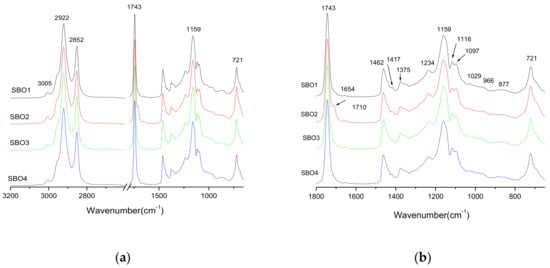
Figure 2.
Comparative ATR-FTIR spectra for sea buckthorn (SBO) oils (SBO1-SBO4) in the whole region (3600–650 cm−1) (a) and in the fingerprint region (1800–650 cm−1) (b).
The dominant peak in the spectra of all eight oil groups were located at 1743 cm−1, corresponding to C=O stretching of fatty acids and esters (whose absorption intensity was normalized at value 1) followed by peaks which were allocated to 19 different subdomains, as presented in Table 3. The most intense peaks (considering the mean intensity values) were located at 2922–2924 cm−1, 1159–1161 cm−1, 2852 cm−1, 719–721 cm−1, 1097 cm−1, 1234–1236 cm−1 and 1460–1462 cm−1. Significant differences between peak intensities were noticed at 2925 and at 2854 cm−1, corresponding to antisymmetric and symmetric stretching vibration of methylene and methyl groups, while the band at 723 cm–1 was assigned to both CH2 rocking and bending vibrations of cis-disubstituted olefins. Specific absorption intensities were noticed at 3008–3009 cm−1, especially in hempseed oils, corresponding to the stretching vibration of olefinic double bonds and explained by its highest degree of unsaturation.

Table 3.
The main FT-MIR absorption wavenumbers and regions identified in ATR-FTIR spectra: mean peak intensity values, RMS, ANOVA p-value, log 10(p), FDR (false discovery rate) and prediction values according to Random forest mean discriminatory accuracy (MDA) values of all samples.
In the fingerprint region, the stretching vibrations of aliphatic and olefinic functional groups were observed. The triglyceride absorption peaks, as major components of edible oils were dominant, with absorptions 2922–2924 cm−1 (C–H asymmetric stretching), 2852 cm−1 (C–H symmetric stretching), 1454 cm−1 (C–H bending (scissoring), 1166 cm−1 (C–O stretching and C–H bending), and 719–721, 790 cm−1 (C–H and -HC=CH- bending) in agreement with different literature data [,,,]. The chemometric techniques, such as PCA and PLS, using Unscrambler were adopted to systematically classify these edible oils based on their FTIR spectra. Classification of edible oils and fats was performed by discriminant analysis using the FTIR spectra between 700–1800 cm−1 and between 700 and 3600 cm−1, respectively. The fingerprint region, and especially the subdomains between 1400 and 1800 cm−1, mostly represents the combination of C–H bending and stretching, and hence is directly related to unsaturated C bonds.
3.3. Classification of Oils by Unsupervised PCA
From the whole spectra (3600–700 cm−1) and for the fingerprint region (1800–700 cm−1), the PCA scores for all oil classifications are shown in Figure 3. Using Unscrambler X10.4 software, the first few PCs described most of the observed variance, showing distinct segregation and clustering between the eight groups of oil. Firstly, for the fingerprint region, an explained variance of 76% (PC1) and 20% (PC2) covered the total variance of 96% (Figure 3). For the whole domain (3600–700 cm−1) the first 2 PCs had an explained variance of 71% (PC1) and 21% (PC2) covering a total variance of 92% and no significant overlapping of samples (data not shown)
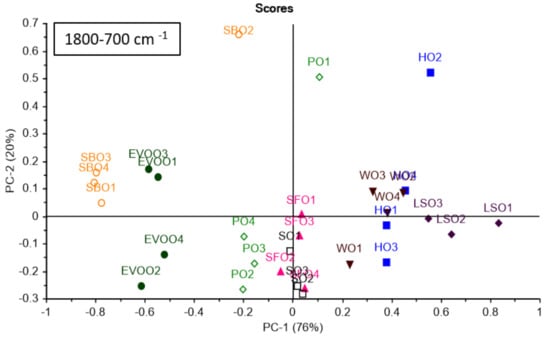
Figure 3.
PCA scores for the oils’ classification using Unscrambler software. Classification based on the peak region 1800–700 cm−1.
Generally, a good discrimination between oil groups was observed and were very similar in both plots. Meanwhile it was possible to identify the individual oils which showed different locations in the plot, against the authentic, genuine samples. Specifically, the position of the SBO2 sample comparing with the authentic sample SBO1, WO1 location comparative to the WO4, LSO1 comparative to LSO3, HO2 comparative to HO4, PO1 comparative to PO4. Meanwhile, for the olive oils, two groups were separated: EVOO1 and 3, the extra virgin ones versus EVOO2 and 4, the virgin labeled oils (in this case no authentic oils could be provided). Only for SFO and SO oils was the grouping compact and close to the authentic samples (SF4 and SO1, respectively).
3.4. Peak-Intensity Matrices and Calculation of the Unsaturation Index
Based on the FTIR spectra, from the initial matrix M0 the individual wavenumbers and their corresponding peak intensities were extracted. There were 19 regions identified having specific wavenumber values for each individual oil, creating a second matrix (M). The statistics data applied on the M matrix using Unscrambler software and by comparison, the Metaboanalyst software are presented in Table 3. For each of the 19 regions, the mean peak intensity, root mean square (RMS), ANOVA p values and log 10(p), and FDR and Random forest MDA (mean discriminatory accuracy) respectively, are presented.
These data reflect in a semi-quantitative way which can be the most significant relevant regions for a good discrimination between the oil groups. The p-value and log 10(p) showed that regions 2, 4, 7, 9, and 13 (bolded) had significant higher values comparatively to regions 16–19, and the less significant ones were regions 5, 8, 10–12, 14, and 15. These data were in good agreement with FDR values and Random forest MDA values.
Meanwhile, the matrix M was used to calculate the unsaturation index (UI), based on the ratio of peak intensities between 2853/3005 cm−1 for each oil group (I to VIII) and for each individual oil. The unsaturation index mean values and standard deviations expressed per oil groups and for individual oils are presented in Figure 4 (upside and downside, respectively).
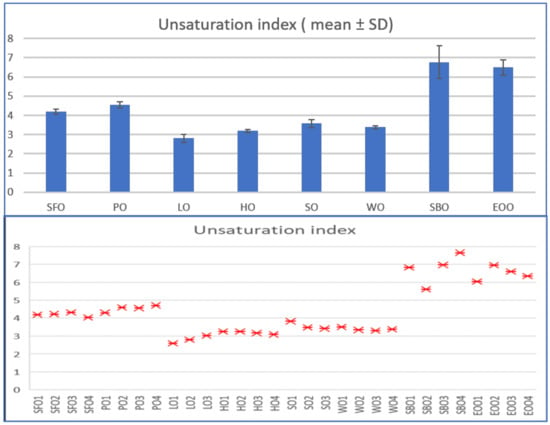
Figure 4.
Mean (upside) and individual (downside) values of the unsaturation index, reflecting the features of the 8 groups of oils, as well as the similarities among oils. SFO—Sunflower oil; PO—Pumpkin oil; LO—Linseed oil; HO—Hempseed oil; SO—Soybean oil; WO—Walnut oil; SBO—Sea buckthorn oil; EOO—Olive oil.
Significant higher values of UI (between 6 and 7) were obtained for group VII and VIII (buckthorn and olive oils), group I and II (sunflower and pumpkin oils) showed values of 4–4.8, and groups III-VI had lowest values of 2.8 to 3.4. Looking to individual UI values, the main differences were confirmed between groups VII-VIII against groups I–II and groups III–VI. Inside some groups there were samples identified which showed deviations from the group values, e.g., sample SBO2 and EOO1 in groups VII-VIII. To conclude, the UI values can be considered good indicators of the general oil quality and may be used as a preliminary evaluation of group authenticity, of course if correlated with other criteria.
3.5. Multivariate Analysis Based on Metaboanalyst 4.0
Using Metaboanalyst algorithms on the matrix M, the PCA analysis (scores and loadings) was performed again (see Figure 5), as well as the PLSDA score plot coupled with the dendrogram derived from cluster analysis (Figure 6).
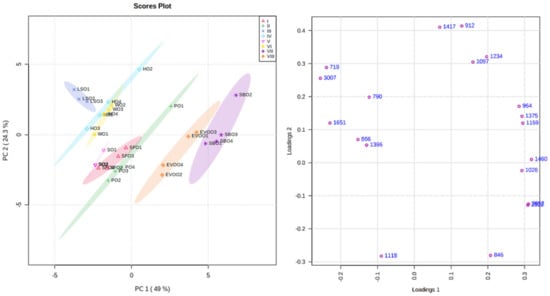
Figure 5.
Graphics of PCA analysis: scores (left) and loadings (right) plots for the 8 groups of oils (I to VIII). For the group individual affiliation and abbreviations see Table 1.
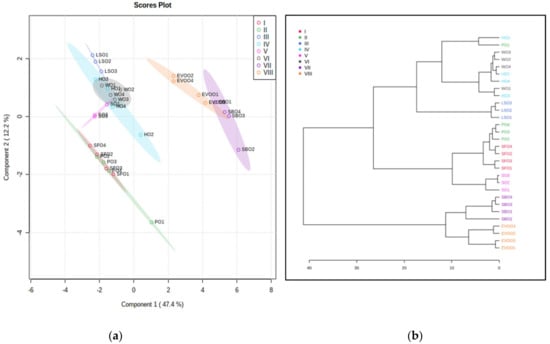
Figure 6.
Partial least squares with discriminant analysis (PLSDA) score plot and dendrogram cluster analysis for the 8 groups of oils (I to VIII). For the group individual affiliation and abbreviations see Table 1. (a) Partial least squares with discriminant analysis (PLSDA) score plot (b) and dendrogram cluster analysis for the 8 groups of oils (I to VIII)
The scores plot shows a good discrimination and classification of oil groups as well as similarities between some groups, such as VII–VIII (see buckthorn and olive oils), I–II–V (sun flower, pumpkin and soybean oils), IV–VI (hempseed and walnut oils) and separately group III (linseed oils). The explained variance was 49% (PC1) and 24% (PC2), covered by a total variance of 73% (Figure 5 left). According to the loadings plot (Figure 5, right) the wavenumbers which may explain this classification are located in 2 main domains, one including the wavenumbers 719, 790, 866, 1118, 1396, 1651, and 3007 cm−1, and the other including the wavenumbers 846, 1026, 2852, and 2922 cm−1. These data are in good agreement with the statistical values mentioned in Table 3.
The PLSDA scores plot showed even a better discrimination between the oils groups I to VIII, with a similar variance of 47.4% (PC1) and 12.2% (PC2) covering a total variance of 59.6% (Figure 6a).
The oil groups VII and VIII (sea buckthorn and olive oils) were better discriminated, the group I–II–V (sunflower, pumpkin and soybean oils) were split, the soybean group being better differentiated. The groups IV and VI (hempseed and walnut oils) remained non differentiated while group III (linseed oils) remained singular. The dendrogram (Figure 6b) shows good and significant clustering between groups VII and VIII, groups I, II and V, and groups IV and VI, exempting one sample of pumpkin oil (PO1) and one sample of hemp oil (HO2). All these data confirm the initial statistical related to the discrepancy of some samples against the authentic ones.
3.6. ANOVA Univariate Analysis and Post-Hoc Analysis by Fischer’s Least Significant Difference (LSD)
Based on the same M matrix, using a cutoff p value < 0.001 and FDR cutoff value of 0.005 (see Table 3), the ANOVA univariate analysis using Random forest algorithm and post-hoc analysis by Fischer’s least significant difference (LSD) were performed. It was possible to rank the most significant wavenumbers which may be considered as predictive biomarkers for a good discrimination among the eight groups of oils. Figure 7 shows the ranking of the first MDA values, useful to identify the significant wavenumbers which may predict the identity and authenticity of these oils. In the left side of the figure, one can see 3007, 2852, 2922, 1396, 717, 1118, 1026, 1651, and 866 cm−1 to be the highest ranked wavenumbers.
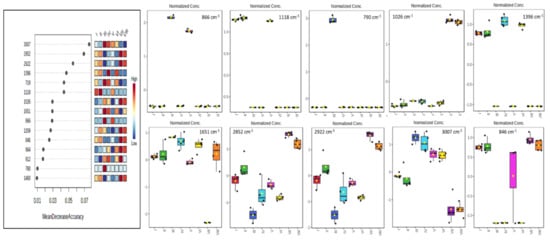
Figure 7.
ANOVA Univariate analysis using Random forest algorithm and post-hoc analysis by Fischer’s least significant difference (LSD) to predict the discrimination between the 8 groups based on specific FTIR-MIR wavenumbers and absorption intensity.
According to the ranking of MDA values presented in Figure 5 (left), one can identify the wavenumbers which may be considered for the most accurate prognosis of oils recognition and discrimination. The most prominent wavenumber was 3007 cm−1 where the normalized peak intensities are significantly different and discriminate four groups of oils (I+II, II+IV, V+VI and VII + VIII) (Figure 5 right). Then, in a decreasing order, the wavenumbers of 2852 and 2922 cm−1 are good predictors of discrimination. For more specific predictions of individual groups, the high intensity at 1118 cm−1 is appropriate to identify groups I and II, 866 and 790 cm−1 for group III, 866 cm−1 for group V, and 1026 cm−1 for groups VII and VIII. These data showed the improved discrimination and prediction capacity of the Random forest algorithm to identify and classify the oils’ type.
3.7. Correlation Matrices and Heatmaps
A more intuitive illustration of the correlations between the oil samples and variables (wavenumbers) was also realized using the Metaboanalyst software The correlation matrices between variables, and between samples (data not shown) were represented graphically and then integrated in the heatmap (correlations between the samples and variables), as presented in Figure 8.
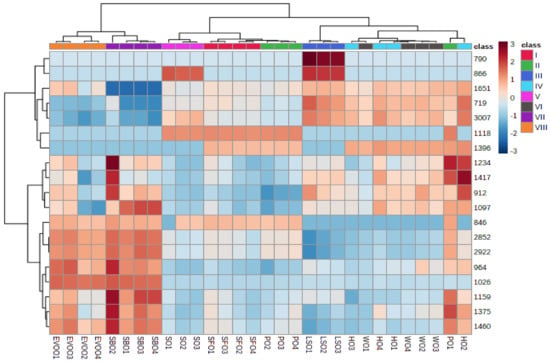
Figure 8.
Heatmap showing correlations between samples and variables.
The heatmap reflect, in an intuitive manner, the positive (reddish colored) correlations between individual samples and their specific wavenumbers to be recognized, as well as the negative relationships illustrated by blue colored spots. In addition, the clustering of the samples is included in the upper part of the matrix.
This illustration is a fast-qualitative evaluation of similarities between the samples from one group and differentiations between the samples and groups in relation to their specific wavenumbers, very useful to confirm their authenticity or adulteration. In such a way, we confirmed that for sunflower oils, the sample SFO1 and SFO2 are qualitatively different from the authentic one SFO4, the same for PO group where sample PO1 is very different compared to the authentic PO4, the same for HO2 comparatively to HO4 (authentic). The groups of SO, WO and LSO oils are more homogenous and seem to all be authentic and of similar quality. Meanwhile for SBO oils, comparatively to the genuine one (SBO1) we identified significant differences for sample SBO2 in its fingerprint, possibly correlated with an adulteration with pumpkin oil (cheaper than sunflower oil and with similar color due to high carotenoid content). The confirmation of this possible adulteration is under investigation by LC-DAD analysis. Finally, for olive oils, a good discrimination is illustrated between the extra virgin (EVOO1 and 3) and virgin oils (EVOO2 and 4). Once again, we consider that Metaboanalyst 4.0, the integrated software adopted for FTIR analysis, proved to be very useful to perform adequate interpretation of analytical data and to accurately reflect the biological significance of the results.
4. Discussion
Considering the main hypothesis of this study and the previous studies directed towards the authentication of functional oils, highly considered by consumers for their health promoting effects, complementary investigation of eight groups of cold pressed oils was achieved. Comparatively to controlled samples labeled as authentic, different commercialized variants were characterized by UV–Vis spectrometry and ATR-FTIR-MIR spectrometry.
The specific recognition groups of the genuine samples were identified, assumed to have the “high-quality” card, as well as the quality of commercial oils of the same botanical origin, which may be mislabeled or adulterated. The complex FTIR spectra were analyzed by chemometrics using successively Unscrambler X.10.4 and Metaboanalyst 4.0 software.
The unsupervised PCA combined with PLSDA, cluster analysis, heatmap, Random forest analysis and ANOVA post-hoc analysis using Fischer’s least significant difference were able to significantly discriminate the botanical groups of oils as well as the differences between individual samples. By integration of the most relevant UV–Vis absorption wavelengths and FTIR absorption fingerprints, considering the main relevant data presented above, we are proposing an intuitive, simplified table, useful for practical reasons, to identify the origin and authenticity and/or quality of commercial edible oils (Table 4).

Table 4.
Criteria of recognition for eight types of functional oils, based on their botanical origin: maximal absorption peaks in the UV–Vis spectra and the ATR-FTIR-MIR wave numbers. For abbreviations, see Table 1.
Complementary studies were conducted, for the same samples, in order to compare the performance of this method with the accurate liquid-chromatography and gas-chromatography analysis coupled with mass spectrometry, focused on specific groups of phytochemicals from these oils. Such data fusion from advanced chromatography and FTIR spectrometry will considerably improve the accuracy and reliability of edible oil characterization and identification.
5. Conclusions
FTIR spectroscopy is a well-established analytical technique for rapid, high-throughput, nondestructive analysis of a wide range of edible oil types, able to detect botanical origin and/or adulteration. Combined with UV–Vis molecular spectroscopy and adequate statistical processing, the potential of FTIR analysis processing complex multispectral information can bring added value knowledge by discrimination, classification, and identification of biomarkers with biological relevance. The results of current investigations presented in this study demonstrated that a succession of chemometric models such as PLS-DA, cluster analysis, and Random forest models had a high predictive ability to detect the oils botanical origin as well as to identify quality differences between individual samples from the same phenotype.
Supplementary Materials
The following are available online at https://www.mdpi.com/2076-3417/10/23/8695/s1, Figure S1: ATR-FTIR-MIR spectra of the eight authentic group oils considering the fingerprint region (1800–650 cm−1). For abbreviations see Table 1.
Author Contributions
Conceptualization, C.S.; Methodology, F.F., F.R.; software, C.S.; validation, A.B., S.S., F.D., formal analysis, F.F., R.F. writing—original draft preparation, C.S. and F.F. writing—review and editing, C.S. and A.P.; supervision, project administration and funding acquisition, C.S. All authors have read and agreed to the published version of the manuscript.
Funding
This research and publication was funded by Executive Unit for Financing Higher Education, Research, Development, and Innovation (UEFISCDI) within the framework of project PN-III-P1-1.2-PCCDI-2017-0046/No. 1/2018, within PNCDI III.
Conflicts of Interest
The authors declare no conflict of interest regarding the content of this article.
References
- Van de Voort, F.R.; Sedman, J.; Russin, T. Lipid analysis by vibrational spectroscopy. Eur. J. Lipid Sci. Technol. 2001, 103, 815–826. [Google Scholar] [CrossRef]
- Socaciu, C.; Ranga, F.; Fetea, F.; Leopold, D.; Dulf, F.; Parlog, R. Complementary advanced techniques applied for plant and food Authentication. Czech J. Food Sci. 2009, 27, S70–S75. [Google Scholar] [CrossRef]
- Su, W.-H.; Sun, D.-W. Mid-infrared (MIR) Spectroscopy for Quality Analysis of Liquid Foods. Food Eng. Rev. 2019, 11, 142–158. [Google Scholar] [CrossRef]
- Maggio, R.M.; Cerretani, L.; Chiavaro, E.; Kaufman, T.S.; Bendini, A. A novel chemometric strategy for the estimation of extra virgin olive oil adulteration with edible oils. Food Control 2010, 21, 890–895. [Google Scholar] [CrossRef]
- Li, Q.; Chen, J.; Huyan, Z.; Kou, Y.; Xu, L.; Yu, X.; Gao, J.-M. Application of Fourier transform infrared spectroscopy for the quality and safety analysis of fats and oils: A review. Crit. Rev. Food Sci. Nutr. 2019, 59, 3597–3611. [Google Scholar] [CrossRef]
- Guillén, M.D.; Cobo, N. Infrared Spectroscopy in the study of Edible Oils and fats. J. Sci. Food Agric. 1997, 75, 1–11. [Google Scholar] [CrossRef]
- Xu, L.; Zhu, X.; Yu, X.; Huyan, Z.; Wang, X. Rapid and Simultaneous Determination of the Iodine Value and Saponification Number of Edible Oils by FTIR Spectroscopy. Eur. J. Lipid Sci. Technol. 2018, 120, 1700396. [Google Scholar] [CrossRef]
- Yang, H.; Irudayaraj, J.; Paradkar, M.M. Discriminant analysis of edible oils and fats by FTIR, FT-NIR and FT-Raman spectroscopy. Food Chem. 2005, 93, 25–32. [Google Scholar] [CrossRef]
- Rodriguez-Saona, L.E.; Allen Dorf, M.E. Use of FTIR for Rapid Authentication and Detection of Adulteration of Food. Ann. Rev. Food Sci. Technol. 2011, 2, 467–483. [Google Scholar] [CrossRef]
- Safar, M.; Bertrand, D.; Robert, P.; Devaux, M.F.; Genot, C. Characterization of edible oils, butters and margarines by Fourier transform infrared spectroscopy with attenuated total reflectance. J. Oil Fat Ind. 1994, 71, 371–377. [Google Scholar] [CrossRef]
- Lai, Y.W.; Kemsley, E.K.; Wilson, R.H. Potential of Fourier transform infrared spectroscopy for the authentication of vegetable oils. J. Agric. Food Chem. 1994, 42, 1154–1159. [Google Scholar] [CrossRef]
- Ozen, B.F.; Weiss, I.; Mauer, L.J. Dietary supplement oil classification and detection of adulteration using Fourier transform infrared spectroscopy. J. Agric. Food Chem. 2003, 57, 5871–5876. [Google Scholar] [CrossRef] [PubMed]
- Gurdeniz, G.; Tokatli, F.; Ozen, B. Differentiation of mixtures of monovarietal olive oils by mid-infrared spectroscopy and chemometrics. Eur. J. Lipid Sci. Technol. 2007, 109, 1194–1202. [Google Scholar] [CrossRef]
- Rusak, D.A.; Brown, L.M.; Martin, S.D. Classification of vegetable oils by principal component analysis of FTIR spectra. J. Chem. Educ. 2003, 80, 541–543. [Google Scholar] [CrossRef]
- Tapp, H.S.; Defernez, M.; Kemsley, E.K. FTIR spectroscopy and multivariate analysis can distinguish the geographic origin of extra virgin olive oils. J. Agric. Food Chem. 2003, 51, 6110–6115. [Google Scholar] [CrossRef]
- Bendini, A.; Cerretani, L.; Di Virgilio, F.; Belloni, P.; Bonoli-Carbognin, M.; Lercker, G. Preliminary evaluation of the application of the FTIR spectroscopy to control the geographic origin and quality of virgin olive oils. J. Food Qual. 2007, 30, 424–437. [Google Scholar] [CrossRef]
- Biancolillo, A.; Marini, F.; Ruckebusch, C.; Vitale, R. Chemometric Strategies for Spectroscopy-Based Food Authentication. Appl. Sci. 2020, 10, 6544. [Google Scholar] [CrossRef]
- Messai, H.; Farman, M.; Sarraj-Laabidi, A.; Hammami-Semmar, A.; Semmar, N. Chemometrics Methods for Specificity, Authenticity and Traceability Analysis of Olive Oils: Principles, Classifications and Applications. Foods 2016, 5, 77. [Google Scholar] [CrossRef]
- Dupuy, N.; Duponchel, L.; Huvenne, J.P.; Sombret, B.; Legrand, P. Classification of edible fats and oils by principal component analysis of Fourier transform infrared spectra. Food Chem. 1996, 57, 245–251. [Google Scholar] [CrossRef]
- Gómez-Caravaca, A.M.; Maggio, R.M.; Cerretani, L. Chemometric Applications to Assess Quality and Critical Parameters of Virgin and Extra-Virgin Olive Oil. A Review. Anal. Chim. Acta 2016, 913, 1–91. [Google Scholar] [CrossRef]
- Godoy, A.C.; dos Santos, P.D.S.; Nakano, A.Y.; Bini, R.A.; Siepmann, D.A.B.; Schneider, R.; Gaspar, P.A.; Pfrimer, P.W.D.; da Paz, R.F.; Santos, O.O. Analysis of Vegetable Oil from Different Suppliers by Chemometric Techniques to Ensure Correct Classification of Oil Sources to Deal with Counterfeiting. Food Anal. Methods 2020, 13, 1138–1147. [Google Scholar] [CrossRef]
- Bertran, E.; Blanco, M.; Coello, J.; Iturriaga, H.; Maspoch, S.; Montoliu, I. Determination of olive oil free fatty acid by Fourier transform infrared spectroscopy. J. Am. Oil Chem. Soc. 1999, 76, 611–616. [Google Scholar] [CrossRef]
- Al-Alawi, A.; van de Voort, F.R.; Sedman, J. New FTIR method for the determination of FFA in oils. J. Am. Oil Chem. Soc. 2004, 81, 441–446. [Google Scholar] [CrossRef]
- Maggio, R.M.; Kaufman, T.S.; Del Carlo, M.; Cerretani, L.; Bendini, A.; Cichelli, A.; Compagnone, D. Monitoring of fatty acid composition in virgin olive oil by Fourier transformed infrared spectroscopy coupled with partial least squares. Food Chem. 2009, 114, 1549–1554. [Google Scholar] [CrossRef]
- Bachion de Santana, F.; Borges Neto, W.; Poppi, R.J. Random forest as one-class classifier and infrared spectroscopy for food adulteration detection. Food Chem. 2919, 293, 323–332. [Google Scholar] [CrossRef] [PubMed]
- Xia, J.; Psychogios, N.; Young, N.; Wishart, D.S. MetaboAnalyst: A web server for metabolomic data analysis and interpretation. Nucleic Acids Res. 2009, 37, W652–W660. [Google Scholar] [CrossRef]
- Bajoub, A.; Bendini, A.; Fernández-Gutiérrez, F.; Carrasco-Pancorbo, A. Olive oil authentication: A comparative analysis of regulatory frameworks with especial emphasis on quality and authenticity indices, and recent analytical techniques developed for their assessment. A review. Crit. Rev. Food Sci. Nutr. 2018, 58, 832–857. [Google Scholar] [CrossRef]
- Le Dreau, Y.; Dupuy, N.; Artaud, J.; Ollivier, D.; Kister, J. Infrared study of aging of edible oils by oxidative spectroscopic index and MCRALS chemometric method. Talanta 2009, 77, 1748–1756. [Google Scholar] [CrossRef]
- Climaco Pinto, R.; Locquet, N.; Eveleigh, L.; Rutledge, D.N. Preliminary studies on the midinfrared analysis of edible oils by direct heating on an ATR diamond crystal. Food Chem. 2010, 120, 1170–1177. [Google Scholar] [CrossRef]
- Cerretani, L.; Giuliani, A.; Maggio, R.M.; Bendini, A.; Toschi, T.G.; Cichell, A. Rapid FTIR determination of water, phenolics and antioxidant activity of olive oil. Eur. J. Lipid Sci. Technol. 2010, 112, 1150–1157. [Google Scholar] [CrossRef]
- Lerma-Garcia, M.J.; Ramis-Ramos, G.; Herrero-Martínez, J.M.; Simó-Alfonso, E.F. Authentication of extra virgin olive oils by Fourier-transform infrared spectroscopy. Food Chem. 2009, 118, 78–83. [Google Scholar] [CrossRef]
- Sinelli, N.; Cosio, M.S.; Gigliotti, C.; Casiraghi, E. Preliminary study on application of mid infrared spectroscopy for the evaluation of the virgin olive oil “freshness”. Anal. Chim. Acta 2007, 598, 128–134. [Google Scholar] [CrossRef] [PubMed]
- Baeten, V.; Fernández Pierna, J.A.; Dardenne, P.; Meurens, M.; García-González, D.L.; Aparicio-Ruiz, R. Detection of the presence of hazelnut oil in olive oil by FT-Raman and FT-MIR spectroscopy. J. Agric. Food Chem. 2005, 53, 6201–6206. [Google Scholar] [CrossRef]
- Vlachos, N.; Skopelitis, Y.; Psaroudaki, M.; Konstantinidou, V.; Chatzilazarou, A.; Tegou, E. Applications of Fourier transform-infrared spectroscopy to edible oils. Anal. Chim. Acta 2006, 573–574, 459–465. [Google Scholar] [CrossRef] [PubMed]
- Muik, B.; Lendl, B.; Molina-Diaz, A.; Valcarcel, M.; Ayora-Canada, M.J. Two dimensional correlation spectroscopy and multivariate curve resolution for the study of lipid oxidation in edible oils monitored by FTIR and FT-Raman. Anal. Chim. Acta 2007, 593, 54–67. [Google Scholar] [CrossRef]
- De Souza, L.M.; de Santana, F.B.; Gontijo, L.C.; Mazivila, S.J.; Neto, W.B. Quantification of Adulterations in Extra Virgin Flaxseed Oil Using MIR and PLS. Food Chem. 2015, 182, 35–40. [Google Scholar] [CrossRef]
- Dulf, F.; Bele, C.; Ungureşan, M.; Parlog, R.; Socaciu, C. Phytosterols as markers in identification of the adulerated pumpkin seed oil with sunflower oil. Bull. Univ. Agric. Sci. Vet. Med. Cluj Napoca Agric. 2009, 66, 301–307. [Google Scholar] [CrossRef]
- Rohman, A.; Ariani, R. Authentication of Nigella Sativa Seed Oil in Binary and Ternary Mixtures with Corn Oil and Soybean Oil Using FTIR Spectroscopy Coupled with Partial Least Square. Sci. World J. 2013, 2013, 740142. [Google Scholar] [CrossRef]
- Rohman, A.; Man, Y.B.; Nurrulhidayah, A.F. Fourier-Transform Infrared Spectra Combined with Chemometrics and Fatty Acid Composition for Analysis of Pumpkin Seed Oil Blended into Olive Oil. Int. J. Food Prop. 2015, 18, 1086–1096. [Google Scholar] [CrossRef]
- Jović, O.; Jović, A. FTIR-ATR adulteration study of hempseed oil of different geographic origins. J. Chemom. 2017, 31, e2938. [Google Scholar] [CrossRef]
- Pop, R.; Buzoianu, A.; Rati, I.; Socaciu, C. Untargeted Metabolomics for Sea Buckthorn (Hippophae rhamnoides ssp. carpatica) Berries and Leaves: Fourier Transform Infrared Spectroscopy as a Rapid Approach for Evaluation and Discrimination. Not. Bot. Horti Agrobot. Cluj Napoca 2014, 42, 545–550. [Google Scholar] [CrossRef]
- Elzey, B.; Pollard, D.; Fakayode, S.O. Determination of Adulterated Neem and Flaxseed Oil Compositions by FTIR Spectroscopy and Multivariate Regression Analysis. Food Control 2016, 68, 303–309. [Google Scholar] [CrossRef]
- Liang, P.J.; Wang, H.; Chen, C.Y.; Ge, F.; Liu, D.Q.; Li, S.Q.; Han, B.Y.; Xiong, X.F.; Zhao, S.L. The Use of Fourier Transform Infrared Spectroscopy for Quantification of Adulteration in Virgin Walnut Oil. J. Spectrosc. 2013, 1, 101–109. [Google Scholar] [CrossRef][Green Version]
- Akin, G.; Karuk Elmas, Ş.N.; Arslan, F.N.; Yilmaz, İ.; Kenar, A. Chemometric classification and quantification of cold pressed grape seed oil in blends with refined soybean oils using attenuated total reflectance–mid infrared (ATR–MIR) spectroscopy. LWT Food Sci. Technol. 2018, 100, 126–137. [Google Scholar] [CrossRef]
- Amit; Jamwal, R.; Kumari, S.; Dhaulaniya, A.S.; Balan, B.; Kelly, S.; Cannavan, A.; Singh, D.K. Utilizing ATR-FTIR spectroscopy combined with multivariate chemometric modelling for the swift detection of mustard oil adulteration in virgin coconut oil. Vib. Spectrosc. 2020, 103066. [Google Scholar] [CrossRef]
- Arslan, F.N.; Çağlar, F. Attenuated Total Reflectance–Fourier Transform Infrared (ATR–FTIR) Spectroscopy Combined with Chemometrics for Rapid Determination of Cold-Pressed Wheat Germ Oil Adulteration. Food Anal. Methods 2019, 12, 355–370. [Google Scholar] [CrossRef]
- Leopold, L.F.; Leopold, N.; Diehl, H.A.; Socaciu, C. Quantification of carbohydrates in fruit juices using FTIR spectroscopy and multivariate analysis. Spectroscopy 2011, 1–12. [Google Scholar] [CrossRef]
- Banc, R.; Loghin, F.; Miere, D.; Fetea, F.; Socaciu, C. Romanian wines quality and authenticity using FT-MIR spectroscopy coupled with multivariate data analysis. Not. Bot. Horti Agrobot. Cluj Napoca 2014, 42, 556–564. [Google Scholar] [CrossRef]
- Coldea, T.E.; Socaciu, C.; Fetea, F.; Ranga, F.; Pop, R.M.; Florea, M. Rapid Quantitative Analysis of Ethanol and Prediction of Methanol Content in Traditional Fruit Brandies from Romania, using FTIR Spectroscopy and Chemometrics. Not. Bot. Horti Agrobot. Cluj Napoca 2013, 41, 143–149. [Google Scholar] [CrossRef]
- Coldea, T.E.; Mudura, E.; Socaciu, C. Advances in distilled beverages authenticity and quality testing. In Ideas and Applications toward Sample Preparation for Food and Beverage Analysis; Stauffer, M., Ed.; InTech: Rijeka, Croatia; London, UK, 2017; ISBN 978-953-51-3686-6. [Google Scholar] [CrossRef]
- Poiana, M.A.; Alexa, E.; Munteanu, M.F.; Gligor, R.; Moigradean, D.; Mateescu, C. Use of ATR-FTIR Spectroscopy to Detect the Changes in Extra Virgin Olive Oil by Adulteration with Soybean Oil and High Temperature Heat Treatment. Open Chem. 2015, 13, 689–698. [Google Scholar] [CrossRef]
- Tay, A.; Singh, R.K.; Krishnan, S.S.; Gore, J.P. Authentication of Olive Oil Adulterated with Vegetable Oils Using Fourier Transform Infrared Spectroscopy. LWT Food Sci. Technol. 2002, 35, 99–103. [Google Scholar] [CrossRef]
- Irnawati, I.; Riyanto, S.; Martono, S.; Rohman, A. The employment of FTIR spectroscopy and chemometrics for authentication of pumpkin seed oil from sesame oil. Food Res. 2019, 4, 42–48. [Google Scholar] [CrossRef]
Publisher’s Note: MDPI stays neutral with regard to jurisdictional claims in published maps and institutional affiliations. |
© 2020 by the authors. Licensee MDPI, Basel, Switzerland. This article is an open access article distributed under the terms and conditions of the Creative Commons Attribution (CC BY) license (http://creativecommons.org/licenses/by/4.0/).